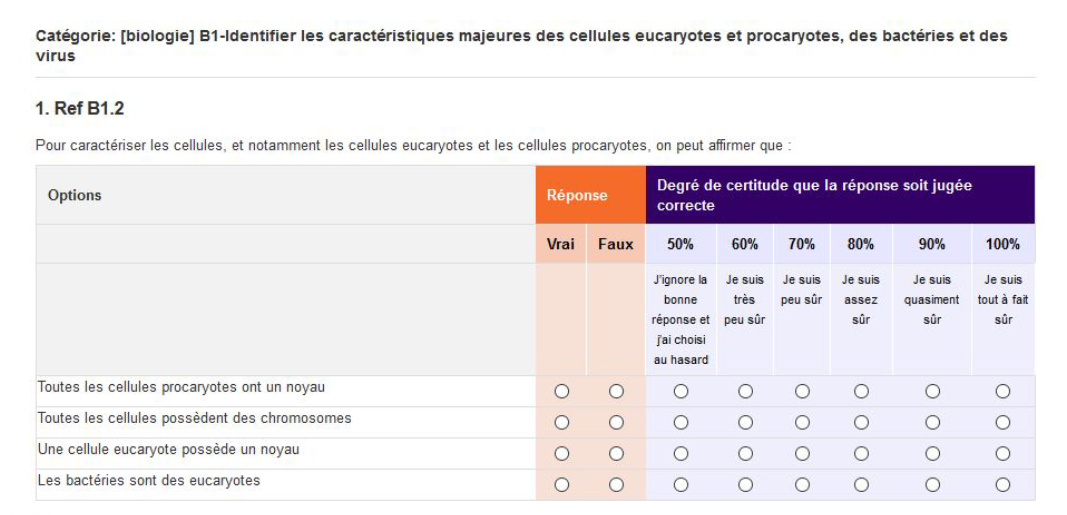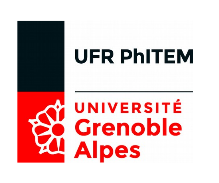We wanted to share an amazing contribution from the University of Grenoble Alpes for Chamilo, integrated into version 1.11.8, directly related to students’ self-assessment during their university integration, particularly for prerequisite tests with certainty levels. In short, a new type of question added to the already extensive list available in Chamilo!
Inspired by an article by C. Hoffman (UFR PhITEM and SAPIENS, CNRS, Institut Néel, Grenoble) and H. Borderiou (Chamilo Developer, UGA, SIMSU), which is publicly available in full via this link: https://chamilosimsu.files.wordpress.com/2018/06/hubert_borderiou_grenoble-geomatice-2018.pdf
These tests with certainty levels in Chamilo were presented at the 8th edition of Géom@TICE, an event hosted by the National School of Geographic Sciences. We warmly invite you to explore the presentations from the Géom@TICE2018 conference, an event designed for e-learning and geomatics professionals.
But let’s get back to the presentation directly relevant to Chamilo users, which essentially promotes metacognition among students through assessments with certainty levels—encouraging students to reflect on their choices during a test by assessing their degree of certainty.
The University of Grenoble Alpes has developed a new type of question specifically for Chamilo and decided to share the code with the Chamilo community (https://github.com/chamilo/chamilo-lms/pull/2485), allowing all users to benefit from this feature since the release of Chamilo version 1.11.8! A contribution that benefits everyone!
This is one of the key advantages of open-source solutions: the improvements made by the community benefit everyone, ensuring the continuous evolution of the tool according to the real needs of users! Chamilo enjoys an active and ever-expanding community of contributors. The future of Chamilo looks promising, and that’s great news! The diversity of institutions, schools, universities, businesses, and training centers using Chamilo continues to grow, constantly adding value through their feedback and contributions.
What are the benefits of prerequisite tests with certainty levels?
This system triggers a process of self-assessment and self-regulation by requiring the student to provide an answer to each question (true/false) while selecting a certainty level regarding the accuracy of their response:
- 50%: I don't know the correct answer and chose randomly.
- 60%: I'm very unsure.
- 70%: I'm unsure.
- 80%: I'm fairly sure.
- 90%: I'm almost sure.
- 100%: I'm completely sure.
Additional information warns about the relevance of the choice:
- If you don’t know the correct answer, select 50% certainty, but still answer. This means you guessed.
- If you select 100%, it means you’re completely sure of your answer.
- Otherwise, choose an intermediate percentage.

This questioning process encourages reflection on what one knows, how one knows it, and why one knows it. It serves as the starting point for learning metacognition—the ability to understand oneself and optimize one’s learning capabilities. In short, it’s a way to encourage students to be aware of their knowledge, uncertainties, and to develop a reflective approach to improve their understanding and learning skills.
Discover the full system in this publication: https://chamilosimsu.files.wordpress.com/2018/06/hubert_borderiou_grenoble-geomatice-2018.pdf
The test conclusion shows results with a color-coded scale from dark green to red, as follows:
- Dark green: Certain knowledge: your answer is correct, and you’re 80% sure or more—congratulations!
- Light green: Fragile knowledge: your answer is correct, but you were unsure (certainty 60% or 70%).
- White: Declared ignorance: you didn’t know the answer—certainty level 50%.
- Pink: Presumed error: your answer is incorrect, but you were unsure (certainty 60% or 70%).
- Dangerous error: your answer is incorrect, and you were confident (80% or more) that it was correct.
This information positively impacts learner tracking and their own understanding of their progress.
Results without a global grade, but in the form of histograms
In this system, no global grade is provided. Instead, a histogram is displayed to visualize the results based on various criteria, such as:
- Dangerous error
- Presumed error
- Declared ignorance
- Fragile knowledge
- Certain knowledge
Results histogram for questions in Chamilo LMS

If you'd like to explore the free online demonstration campus offered by the Chamilo Association, visit https://campus.chamilo.org/en and create a teacher account. If you prefer to test your own portal as an administrator, you can download the latest version from their website: https://chamilo.org/en/download/.
For more specialized technical services, you can also contact BeezNest, one of Chamilo's official service providers: https://chamilo.org/en/providers/.
For more information, visit https://chamilo.org/en.




